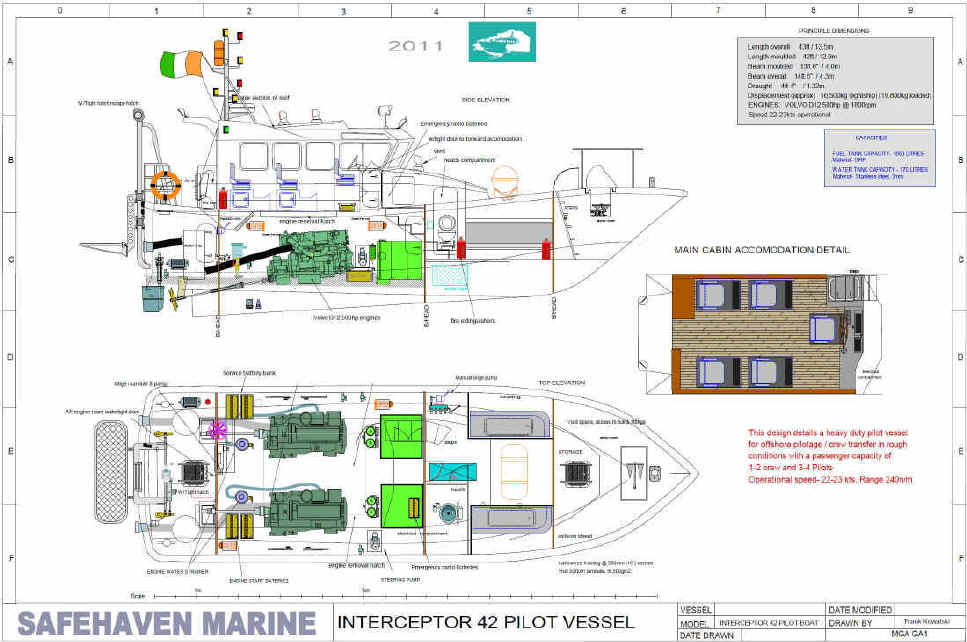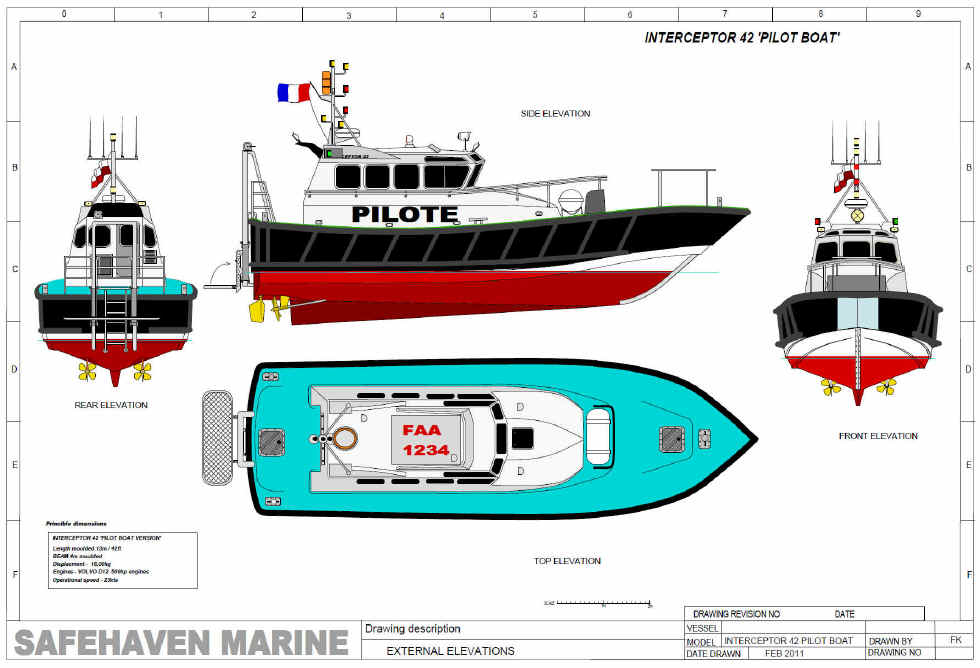| INTERCEPTOR
42 (13m) PILOT DESIGN
|
|||||
|
SPECIFICATION
L.O.A. Length Moulded BEAM Beam moulded Draft Displacment Lightship Pilot seating capacity Fuel capacity Engines Power output Gearboxes Generator Speed Operational Maximum Certification
Alongside ship boarding trials
Sea keeping & handling trials
Roenne Pilot in Force 8-9
Dublin & Malta Pilots together in Force 8-9
|
43ft / 13.4m 12.8m 4m 4.3m 1.3m
16,500kg 4 -5 pilots, 1 crew 1800 litres Volvo D12 500hp Twin Disc 5114 22-23kts 22-23kts Bureau VerItas |
In the
cabin, the arrangement features a central helm position. This means
boarding can take place to the side best suited to the prevailing
conditions, as both port and starboard side benefit from equal
visibility. In addition the helmsman’s seating and steering position
has been designed with car like ergonomics in mind, allowing fatigue
free operation, where all controls fall easily to hand. Visibility is
maximized by the use of forward slopping front windows, to easily shed
water and reduce glare and reflections. Upper level skylights and roof
windows give a clear view overhead. Front screens are demisted by an
efficient hot air heater / demister to ensure good visibility at all
times. Instrumentation and electronics have been positioned to provide
easily viewed navigation and vessel information. A comprehensive
electronics package is fitted consisting of two 12" colour
displays screens providing GPS plotter navigation, sounder and radar,
in addition, AIS readout is integrated into the main displays and
a rudder angle position and log provides further information. The layout
inside is quite unique. Instead of the usual six pilot seats, (which can
be accommodated if required) there are four pilot seats, the aft two
have a table in front, and one has a navigation console with a 12"
navigation repeater and VHF incorporated. This provides the pilot with a
very comfortable seated position, his own navigation station and access
to important information, particularly in adverse weather conditions
while communicating with approaching vessels. Cameras positioned on the
wheelhouse roof looking at at the transom and engine room provide the
helmsman with selectable video images displayed on the display units,
The transom camera can be invaluable to the coxswain in the event of an
emergency recovery as normally the area directly below the transom is
not visible from the helm. In the event of a MOB situation arising,
recovery will be easily facilitated by a MOB recovery basket which is
single handedly deployed down to below the WL, allowing an unconscious
person to be recovered efficiently in a horizontal position and lifted
up to the weather deck. When not in use the system folds back into the
transom out of the way. The
main cabin is finished in a combination of durable formica laminates of
the customers choice, black GRP moldings for helm and seat pedestals,
and the cabin is lined in a grey sidelining carpet, providing insulation
and a warm environment. Access to the forward accommodation is through a
water tight hatch, steps leads down to a spacious area containing
seating and occasional berths. There is also plenty of storage space, a
basic galley can be provided for the crew here if required. A separate
heads compartment fitted with a manual toilet is situated to starboard. The pilot 42 is typically powered by a pair of Volvo D12 engines rated at 500hp @ 1800rpm continuous. This provides her with a required operational speed of 22-23kts. Another important feature is the ability for quick engine replacement in the event of a failure. To this end a large hatch is built into the superstructure roof which can be quickly removed, the four pilot seats can then be unbolted ant the completed seating modules removed. A large hatch situated in the cabin sole is unlatched and hinged back, allowing the engines to be quickly removed.
Safehaven Marine, Ashgrove, Cobh, Co Cork, Ireland Phone 00353 86 8054582 Email- info@safehavenmarine.com safehavenmarine@eircom.net
|
|||


